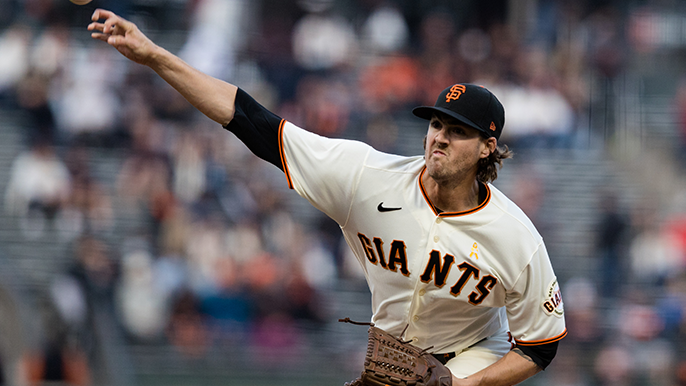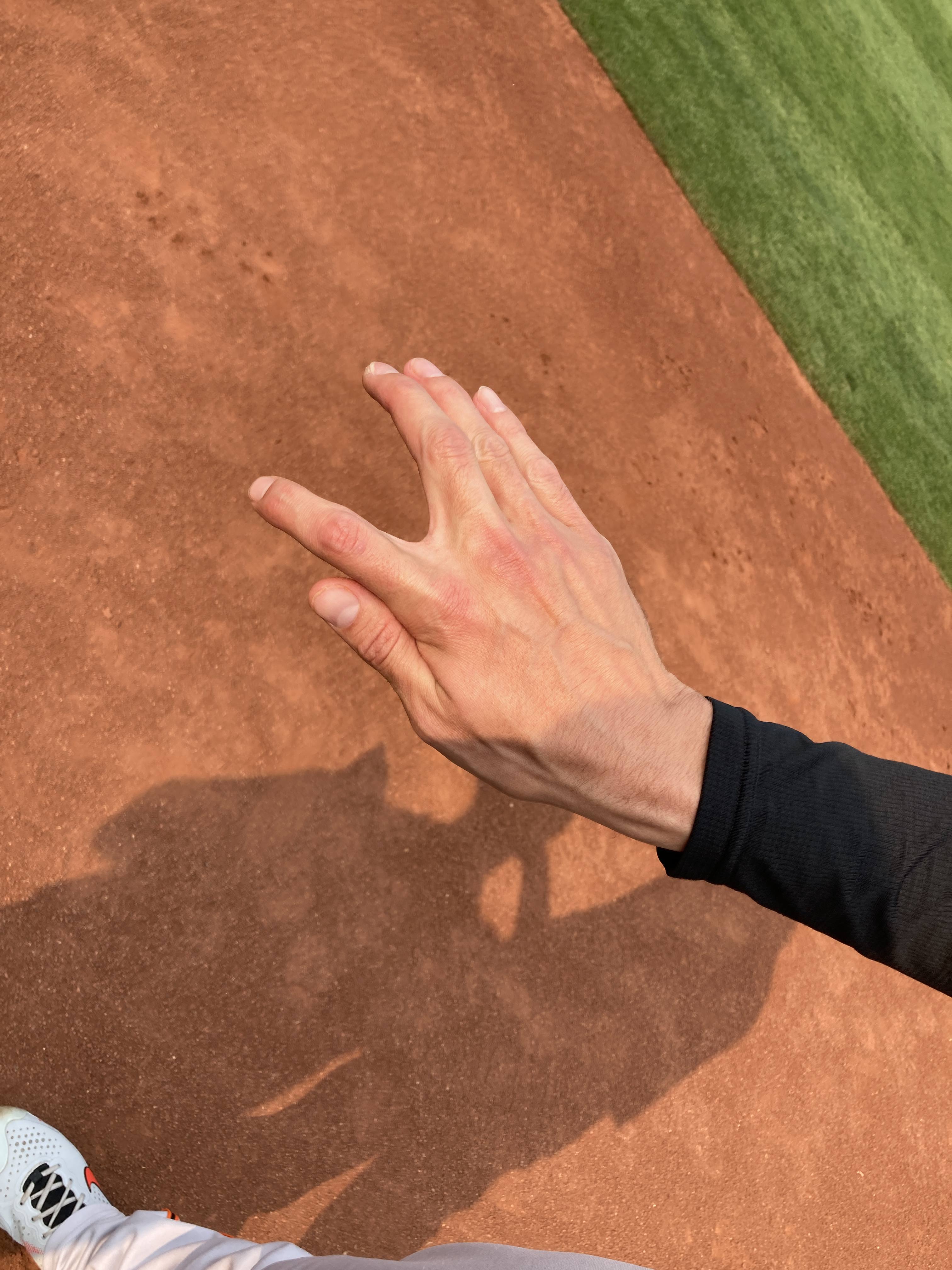© John Hefti | 2021 Sep 1
Before Aug. 20’s game against the Oakland Athletics, Kevin Gausman mozied over to the on-field bullpen on the Coliseum field. He held up a ball in front of his and Jarlin García’s faces, showing the left-handed reliever how he grips his split-fingered fastball.
Major League pitchers don’t often marvel at each other’s fastball, curveball or slider grips. But people ask Gausman about his primary pitch all the time, he said. The splitter has become a rarity; among MLB pitchers who have tossed at least 70 innings, just 17 have thrown at least one splitter. Gausman, at 36.7%, has used his by far the most frequently.
While he’s stuck in the era of juiced spin rates, 100 mph fastballs and sweeping offspeed pitches, Gausman is pitching like it’s the 1980’s.
Yes, the 1980’s. And it’s working.
Entering Monday’s start against the Rockies in Colorado, Gausman has rode his splitter to a 12-5 record and 2.52 ERA. He’s done it as the splitter is becoming anachronistic; in 2002, the first year Fangraphs tracked pitch type data, 54 pitchers featured a splitter. That jumped up to over 80 the next two seasons and stayed above 50 until 2007. Less than 20 pitchers featured it each of the past two seasons.
There are theories to explain the splitter’s decline through the years, but one thing is clear: Gausman’s go-to pitch isn’t going anywhere.
“For me, the reason why my split is so good is because I haven’t been able to spin the ball very well, so I’ve had to rely on other things,” Gausman told KNBR. “I just think it’s an outlier pitch.”
It wasn’t always like that, though.
Baseball historians point to the 1980s, led by Cy Young award-winner Bruce Sutter, as the splitter’s introduction into the mainstream. Former Angels manager Mike Scioscia told the Associated Press in 2011 that “everyone was throwing” splitters.
“It was the pitch of the ’80s just like the pitch of the ’60s was a slider,” Scioscia, a catcher for the Dodgers in the 1980s, said.
The pitch, with the ball gripped between the index and middle finger, looks like a fastball until it falls off the table before the plate. At least good ones do.
The pitch made its way through from the 80s into the next decades, with Roger Clemens, Curt Schilling and Roy Halladay. Stars like Yu Darvish and Shohei Ohtani throw it in 2021, and they’re unicorns for throwing the pitch at all.
But Gausman is at a different level. No starter in the Fangraphs pitch tracking era has thrown a split-fingered fastball more often than Gausman. Only three pitchers — Koji Uehara in 2013 (48.3%); Hector Neris in both 2016 and 2017; and Edward Mujica — have thrown it more often. And those were relievers who used it as a specialty pitch.
He also throws it differently. Gausman’s junior varsity coach in Centennial, Colorado taught him the “foche” grip, which is essentially a hybrid splitter-changeup. It’s a similar grip that Tim Lincecum used, he explained after showing García.
“Yeah, it’s a really weird grip,” Gausman said. “I run into a lot of people who are like, ‘That’s really how you throw it?’ And I’m like, yeah, that’s what’s comfortable for me.”
Gausman has experienced a renaissance in 2021 because he’s throwing his splitter more often than ever. He tries to throw it as a “strike-ball,” he said, meaning it looks like a strike before dropping out of the zone.
That action is the key behind Gausman’s whiff rate, which is in the 79th percentile, per Baseball Savant. He was especially effective with the splitter in the first half of the season, when he registered a 1.73 ERA.
After the All-Star Break, Gausman’s splitter lost some of its bite, and hitters knew what to expect. “The book is out on me,” he said after lasting only 3.2 innings during SF’s Aug. 21 6-5 win in Oakland. Still, hitters have a .114 batting average when facing Gausman’s splitter on the season and in his most recent outing, it looked as lively as ever.
So why don’t more pitchers feature a split-fingered fastball anymore? Well, there are a few theories.
Former starter Dallas Braden, now a broadcaster for the Oakland Athletics, called the splitter a “feel pitch.” To even try to throw it, a pitcher needs to have sizable hands.
And not only is it hard to throw, it’s also hard to teach, Giants pitching coach Andrew Bailey said. As the splitter’s already a pitch that can have an unpredictable movement profile, the lack of coaches able to help tweak it could factor into its diminishing popularity.
Plus, as more pitchers shift to high-velocity fastballs and sweeping breaking balls, the splitter — a pitch with a low spin rate — goes against in-vogue trends.
There may be health concerns associated with throwing splitters. The 2011 Associated Press story cited the Giants as one of many teams who at one point discouraged pitchers from throwing splitters due to elbow injury concerns.
Braden explained the theory with a demonstration: hold out a ball out in front of your body normally. With your other hand, feel your elbow. Then do the same thing, except put the ball between your pointer and middle finger. There’s a tension in the elbow region just from gripping the pitch, let alone whipping your arm to propel the ball upwards of 90 mph.
But the science behind whether or not splitters put pitchers at higher injury risk isn’t clear. Gausman hasn’t had elbow issues, and neither has Oakland’s Frankie Montas, the No. 2 splitter pitcher of 2021.
Those possible reasons are just theories. Splitters have always been hard to throw, hard to teach, and (potentially) hard on your elbow. In the 1980s, 2002 and today. Nobody can pinpoint exactly why they’re trending out of the game.
What matters most, at least for the Giants, is if Gausman can continue to make one of the most unique pitches in the game one of the most effective.
“It’s such a unique pitch to the pitcher,” Bailey, the pitching coach, said. “God, man, you’re blessed if you have one for sure. Kevin, that’s his bread and butter, and the league knows it. He knows it. The ability and the feel that he has with it is so unique and special.”




